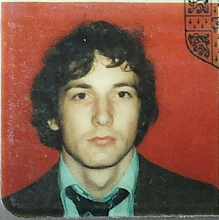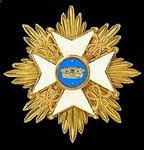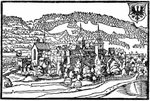 Most European nations at this time employed semi-invalid trained or veteran soldiers as garrison troops, to avoid having to use regular soldiers to do the job, but putting vital fortresses in the hands of troops whose capabilities, morale and motivation were sometimes suspect could be problematic. The Saxons had 8 companies of such troops and this appears to be the main uniform worn by most of them. As well as a musket and bayonet they carried a sabre with brass metalwork and a brown leather scabbard.
Most European nations at this time employed semi-invalid trained or veteran soldiers as garrison troops, to avoid having to use regular soldiers to do the job, but putting vital fortresses in the hands of troops whose capabilities, morale and motivation were sometimes suspect could be problematic. The Saxons had 8 companies of such troops and this appears to be the main uniform worn by most of them. As well as a musket and bayonet they carried a sabre with brass metalwork and a brown leather scabbard.Saxon garrison troop numbers for September 1756 were: 3 companies as garrison at Wittenberg, 354 men; 1 company as garrison at Waldheim [in a grey uniform which I shall depict next], 176 men; 1 company as garrison at Pleissenberg, 115 men; the garrison at Königstein, 195 men; and the garrison at Sonnenstein, 125 men. All these were gathered in to the fortified Camp at Pirna with its Sonnenstein Fortress and which also included the Königstein citadel, along with most of the Saxon army. Unfortunately, from the beginning the plan was botched as equipment, ammunition and food and fodder were in short supply and the Prussian hussars quickly prevented any sorties to acquire more food and fodder. The fortresses were also in a poor state and so the garrisons (who were weak in numbers and condition) were all gathered into the fortress of Königstein, with a newly-arrived Anhalt free company from Wittenberg stationed in Pirna town and Sonnenstein.The camp simply became a large prison camp for the Saxon forces and Frederick wisely kept them bottled up without any attempt to storm it, which would probably have been suicidal, given the difficulty of the terrain. The Saxon army, after an abortive breakout attempt, surrendered on the 16th October to avoid starving to death. The garrison of Königstein (which included the men from Sonnenstein) was the only unit exempted from the surrender and the fortress of Königstein was declared neutral for the duration of the war; the Saxon army's colours and standards were placed there and not taken as trophies of war, the only concession that Frederick made to the Saxons. The other garrison troops were forcibly enlisted in the Prussian army along with the rest of the Saxon units. The cavalry were distributed amongst the Prussian cavalry and the Saxon infantry formed into 10 new infantry regiments. Within months all but 3 of those infantry units had been disbanded because of desertions; many of the Saxon deserters joined the Austrians or the French to continue their war against Frederick, who seems to have had a personal grudge against all things Saxon.
I am grateful to Stefan Schulz for translation work on Francke and Schuster's book of 1885 on the history of the Saxon army and for details from Markus von Salisch: "Treue Deserteure. Das kursächsische Militär und der Siebenjährige Krieg", Munich (Oldenbourg) 2009 - ISBN 978-3-486-58805-7.



















David,
ReplyDeleteIt is nice to see you posting again.
-- Jeff
Hi Jeff,
ReplyDeleteThanks. I've had health problems for some months but am trying to get back into regular posting on the blog again. In the circumstances making a start by depicting Invalid Troops seemed appropriate!
Cheers,
David.
Very nice uniform to start back on. Ideal for one of my imaginations!
ReplyDeleteMel
I love the fact that you give the lesser known subjects attention, like with the Norwegian ski troops.
ReplyDeleteThanks for taking the time and effort to make these for us. Hope you're feeling better.
Sir David, All of Beerstein rejoices at your return...
ReplyDeleteBest wishes on your health and good to see you posting again!
ReplyDeleteI agree, a nice uniform for your return. :)
Thanks, Mel. Glad it will be useful. :-)
ReplyDeleteCheers,
David.
Hi Adam,
ReplyDeleteThanks; yes, I rather like the more obscure units - often much more interesting than the "bog standard" stuff. :-)
Health is hopefully on the way to improving, thanks - next stage an MRI scan to find out more about one particular problem!
Cheers,
David.
Thanks, Bill. Have to get the bells ringing in the cathedral in Tippelbruder too... ;-)
ReplyDeleteCheers,
David.
Thanks, FB. :-)
ReplyDeleteI'm addicted to Saxon uniforms - luckily they have a good variety of types left for me to do.
Cheers,
David.
I popped into Manchester Art Gallery to kill a bit of time before my bus home and came across a painting of the inside of Königstein fortress, painted during the 1750s. There were four of these chaps dotted around the painting; three walking on what seems like a patrol, and an officer or sergeant bowing to his betters. Amazing what you can find by chance, I never expected to see an original depiction (admittedly tiny) of an obscure SYW unit today. Thanks for putting this up so that I knew what I was looking at when I saw it, David.
ReplyDeleteThey also had Lady Butler's painting of the shocked survivors of the charge of the light brigade, the painting of Ney and the rearguard on the retreat from Moscow, and Joshua Reynolds painting of the WAS British officer Lord Cathcart. Overall, I'm quite glad I mised the earlier bus.
Hi Adam,
ReplyDeleteA nice bit of serendipity (and good that the template helped)! :-) I think I found your painting on the MAG site:
The Fortress of Konigstein: Courtyard with the Brunnenhaus
painting
Bellotto, Bernardo
Europe
1756 = 1758 (circa)
There are some very good things (like those history paintings) in northern British galleries; I'd like to get to Sheffield some day to see the Ernest Croft paintings they have, many of the Waterloo campaign, which I've enjoyed in books since I was a boy.
Did they have any postcards of the paintings? (These days I know it's not so common...)
Cheers,
David.
I think they had postcards of some of the paintings from the gallery, but whether or not they will have one of this particular one is another question entirely. I'm in the centre of Manchester most weekends so I'll pop in at some point to have a look. I'll see if I can get some photos of the detail of the painting while I'm there as the photos on the gallery's website are miniscule (though they might not be the best as I won't be able to use a flash).
ReplyDeleteYour post on this unit was especially helpful as, though I could remember the uniform, I was left scratching my head as to why there were Saxons guarding a Saxon fortress in a painting done after the surrender at Pirna.
I've never been to Sheffield's but Liverpool's does have a couple of military paintings. They have two versions of the death of Nelson, including the Benjamin West one, Napoleon crossing the Alps by
Paul Delaroche and a painting of the French rout after Waterloo (Although not all of these are listed on their website, they are there).
Hi Adam,
ReplyDeleteI'll be interested to see what they have; thanks. And also especially interested in details from that painting! :-)
There's quite a lot on Wikipedia on Konigstein including some of the Bellotto paintings; it's now a museum and looks like an amazing place, with tremendous views down the river. Perhaps one day...
Thanks for mention of the Liverpool paintings; is the rout after Waterloo the Ernest Crofts painting?
Cheers,
David.
Yes, it is the Ernest Crofts painting. I did a search on that name and it is this one, with Napoleon's grenadiers holding back the routed soldiers:
ReplyDeletehttp://www.military-art.com/mall/images/dhm010.jpg
The other Trafalgar painting is 'The Death of Nelson' 1859-64, by Daniel Maclise:
http://www.liverpoolmuseums.org.uk/picture-of-month/graphics/large/nelson.jpg
Adam
Hi Adam,
ReplyDeleteThanks; really like that painting. First saw it in a book on Waterloo when I was a boy, along with other Crofts' paintings.
Maclise did some tremendous stuff too; he has murals in the Houses of Parliament on Waterloo and Trafalgar.
Cheers,
David.
Hi David
ReplyDeleteI passed through Manchester yesterday so I popped into the art gallery. I was surprised to find that they did have postcards of all but one of the paintings I mentioned, including a second Konigstein painting that wasn't on display. I got you some when I got some for myself. If you email me your address I'll post them over to you.
I also managed to get a couple of photos of the detail. Unfortunately my hand was a bit shaky and the portions of the painting were quite small anyway, so the quality of them isn't the best:
Elderly and frail senior officer escorted past a bowing garison troops officer. He is accompanied by a man in western civilian clothing, a man in hussar-style uniform who has a Polish/tartar haircut rather than the usual pigtails, and a man in Polish dress bringing up the rear.
http://i773.photobucket.com/albums/yy18/AdamfromLancashire/RIMG0147.jpg
A trio of garrison troops walk past a disheveled looking man who may well be an invalid soldier. There was another man propped up against a wall elsewhere in the painting. (Sorry this one is a little bit blurred)
http://i773.photobucket.com/albums/yy18/AdamfromLancashire/RIMG0146.jpg
Hi Adam,
ReplyDeleteThank you very much! It's good to have those detailed shots from the painting. (I know how tricky getting good shots without flash in dark galleries is so I think you've done a good job of those.) Of course I'll pay for the postcards and postage on them too. It's impressive that they have so many postcards.
I don't have an email address for you so could you send me a quick email to: morfitt [at] lineone [dot] net , please, and I'll reply with my address ASAP? I feel a bit wary of putting my full postal address on this blog - too public!
Thanks very much again.
Cheers,
David.
They also had A3 prints for a lot of the paintings in the gallery, but the only military print they had was of Marshal Ney's rearguard. I would have loved to have a framed version of that Saxon fortress. Still, I should be grateful for the fact they've gone to the effort of producing postcards for such an obscure subject matter.
ReplyDeleteIt's a pity Liverpool's gift shop didn't have the same range of products available. I would have loved a print of Daniel Maclise's Trafalgar.
Hi Adam,
ReplyDeleteYes, it is impressive that Manchester have such a good selection of prints and postcards - not very common these days. Pity about the Konigstein picture, though! I imagine there's probably a limited audience for that...
The Liverpool Maclise of Trafalgar is, as I suspected it might be, a copy of the splendid Parliament wall painting; there's a good page with details here: http://www.explore-parliament.net/nssMovies/01/0100/0100_.htm and a decent panoramic shot of the whole thing here: http://www.defencedynamics.mod.uk/wewerethere/preww/images/death_of_nelson_lg.jpg I agree that it would make a good large print!
Cheers,
David.